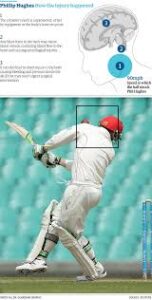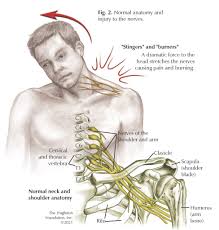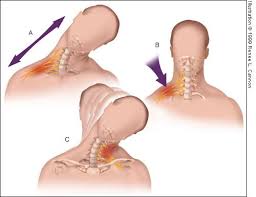

Forward neck tilt, also known as forward head posture (FHP), is a prevalent postural issue where the head protrudes in front of the shoulders.
This misalignment places significant strain on the cervical spine and surrounding muscles, potentially leading to discomfort, stiffness, and chronic pain. While modern lifestyle habits such as prolonged screen time contribute to FHP, sports injuries are an often-overlooked factor.
This article explores the connection between sports-related injuries and forward neck tilt, detailing how trauma to the cervical spine and surrounding musculature can lead to postural deviations.
We will also discuss the biomechanics involved, preventive strategies, and rehabilitation techniques to mitigate the effects of FHP caused by sports injuries.
In This Article:
- Understanding Forward Head Posture
- Definition and characteristics
- Common causes
- The Anatomy of Neck Posture
- Muscles involved
- Spinal alignment and posture control
- Sports Injuries Leading to Forward Neck Tilt
- Whiplash injuries
- Cervical spine fractures
- Muscle strains and ligament sprains
- Concussions and their impact on neck posture
- Biomechanical Pathways from Injury to FHP
- Muscle imbalances
- Altered movement patterns
- Pain avoidance behaviors
- Preventive Measures in Sports
- Proper training techniques
- Use of protective equipment
- Strengthening and flexibility programs
- Rehabilitation Strategies
- Physical therapy and corrective exercises
- Postural correction techniques
- Role of ergonomics in recovery
- Long-Term Implications of Unaddressed FHP
- Chronic pain and musculoskeletal strain
- Reduced athletic performance
- Overall quality of life
Understanding Forward Neck Tilt
Here is a quick look at what forward head slide really means. We shall also discuss the main reasons why this condition happens:
Definition and Characteristics:
Forward head posture (FHP) is a condition where the head moves forward from its neutral alignment, positioning the ear lobes ahead of the shoulders.
This postural deviation increases the load on the cervical spine, leading to excessive strain on the supporting muscles and ligaments.
According to Medical News Today, FHP is becoming increasingly common due to prolonged screen exposure, desk work, and lack of physical activity. However, sports injuries also play a significant role in disrupting neck posture.
Common Causes:
While habitual poor posture is a well-known contributor to FHP, sports injuries are often overlooked as a causative factor.
As per Spine-Health, direct trauma to the cervical spine or repeated stress from high-impact sports can lead to chronic postural misalignment.
The Anatomy of Neck Posture
It is vital for every sportsperson to understand how his/her neck functions. Only then can she or he fully comprehend how to fix any injury caused to it while playing a sport:
Muscles Involved:
Several key muscle groups influence neck posture:
- Deep cervical flexors: These muscles at the front of the neck help maintain head alignment. Weakness in this area can cause a forward shift in head position.
- Erector spinae: These muscles run along the spine, supporting an upright posture. When weak or imbalanced, they contribute to FHP.
- Upper trapezius and levator scapulae: These muscles, when overactive, contribute to tightness in the upper back and neck, further promoting FHP.
According to Spine-Health, a muscle imbalance between the deep cervical flexors and the upper trapezius can be a primary cause of forward neck tilt.
Spinal Alignment and Posture Control:
Your neck, that marvelous pedestal holding up your noggin, has a built-in curve called lordosis—nature’s way of keeping things balanced. But when you spend hours hunched over screens like a human question mark, that elegant curve turns into an exaggerated mess.
Enter forward head posture, the villain of spinal alignment! This awkward positioning overloads your vertebrae and intervertebral discs, forcing them to work overtime.
According to the American Association of Neurological Surgeons, this chronic misalignment can fast-track degenerative disc disease and gift you with never-ending neck pain. So, unless you fancy a future of discomfort, straighten up!
Sports Injuries Leading to Forward Neck Tilt
BestForwardHeadPostueFix research team has identified four major sport related injuries that can lead to a forward head slide. A quick look at each of these in brief:
Whiplash Injuries:
Whiplash occurs when the neck experiences rapid flexion and extension, often seen in contact sports like football and wrestling.
This sudden motion can cause micro-tears in muscles and ligaments, leading to a weakened cervical structure and contributing to FHP. According to Physio-Pedia, untreated whiplash injuries often result in long-term postural problems.
Cervical Spine Fractures:
Severe impacts in sports like rugby or gymnastics can lead to cervical spine fractures. The American Association of Neurological Surgeons states that even after healing, residual stiffness and muscle compensation patterns can cause forward neck tilt.
Muscle Strains and Ligament Sprains:
Straining or overstretching neck muscles and ligaments affects posture control. A study published on PubMed suggests that even mild sports-related neck injuries can contribute to prolonged muscle imbalances, leading to forward head posture.
Concussions and Their Impact on Neck Posture:
Head trauma affects neuromuscular control, sometimes leading to compensatory postures like FHP. A research paper on the National Institutes of Health (NIH) website highlights how concussions can disrupt the brain’s ability to regulate postural control, indirectly causing forward neck tilt.
Biomechanical Pathways from Injury to FHP
Let us walk you through these in brief:
Muscle Imbalances:
When an injury weakens specific muscle groups, others compensate, leading to poor posture. According to Spine-Health, weakened deep cervical flexors often result in overactivity of neck extensors, reinforcing forward head posture.
Altered Movement Patterns:
Athletes often develop compensatory movement patterns post-injury. As per the British Journal of Sports Medicine, these altered biomechanics can persist even after injury recovery, leading to chronic postural deviations.
Pain Avoidance Behaviors:
Athletes may unconsciously adopt protective postures to minimize pain, further exacerbating forward neck tilt. The Journal of Physical Therapy Science states that prolonged avoidance behaviors can lead to long-term musculoskeletal dysfunction.
Preventive Measures in Sports
A quick look at how sportsperson can prevent such injuries from taking place:
Adopting Proper Training Techniques:
Training with correct neck mechanics is crucial in reducing the risk of injury, especially in contact sports like football, wrestling, and rugby.
Coaches and trainers should emphasize maintaining proper cervical alignment during movements, ensuring athletes do not excessively strain their necks.
For instance, when tackling in football, players should keep their heads up rather than leading with their helmets—a technique known as “heads-up tackling” to prevent spinal injuries.
According to the American Journal of Sports Medicine, improper neck posture during training can increase the risk of whiplash injuries, muscle strains, and even long-term postural defects.
Use of Protective Equipment:
Neck braces and padded headgear are vital tools in injury prevention, particularly in high-impact sports where sudden jolts to the head and neck are common.
Helmets in American football, for example, are designed with shock-absorbing padding to reduce the impact force transmitted to the cervical spine.
An article in The Guardian highlights studies showing that protective gear significantly lowers the incidence of neck trauma.
In motorsports, devices like the HANS (Head and Neck Support) system help prevent excessive neck motion during crashes, reducing the risk of life-altering cervical spine injuries.
Strengthening and Flexibility Programs:
Regular neck-strengthening and mobility exercises play a crucial role in maintaining proper posture and preventing forward head posture (FHP).
Exercises such as chin tucks, resistance band stretches, and isometric neck holds enhance muscular endurance and spinal stability.
According to an article in The Guardian, resistance training targeting the neck muscles can decrease the likelihood of postural misalignment, ultimately preventing chronic pain and degenerative disc disease.
Additionally, yoga and Pilates can improve flexibility and mobility, further supporting cervical spine health.
Rehabilitation Strategies
Oh, the perils of modern life! Our obsession with screens has led many of us down the crooked path of forward head posture (FHP). But fear not, for there are ways to straighten things out—literally.
Physical Therapy and Corrective Exercises:
Imagine your head as a bowling ball (weighing about 10-12 pounds) perched atop a delicate stack of bones.
Now, picture that ball inching forward with each text message.
The result?
Strained muscles and a not-so-happy neck. Enter physical therapy: the superhero aiming to restore strength and flexibility.
According to a study published in the Journal of Orthopaedic & Sports Physical Therapy, targeted physical therapy can effectively reverse FHP caused by various factors, including sports injuries.
The National Institutes of Health (NIH) also emphasizes that structured rehabilitation programs focusing on strengthening and flexibility can gradually correct poor neck alignment.
Postural Correction Techniques:
Let’s talk exercises—specifically, those that make you look slightly ridiculous but work wonders.
Chin tucks, where you glide your head back as if avoiding an awkward kiss, strengthen the deep cervical flexors.
Thoracic extensions, which involve arching your upper back over a chair like a stretching cat, help mobilize the thoracic spine.
And scapular retractions?
Imagine squeezing a pencil between your shoulder blades.
Research published in the Journal of Orthopaedic & Sports Physical Therapy confirms that consistent practice of these movements can significantly improve FHP by retraining posture-supporting muscles.
Role of Ergonomics in Recovery:
Now, let’s address the battleground: your workspace. If your desk setup resembles a chaotic art installation, it is time for a makeover.
Proper ergonomics during daily activities, including screen time and sleeping postures, play a crucial role in preventing postural relapse.
Harvard Medical School recommends ergonomic modifications—such as keeping screens at eye level, using lumbar support chairs, and ensuring neutral neck positions during sleep—to complement rehabilitation efforts.
In conclusion, while our gadgets may have led us astray, a combination of targeted exercises and ergonomic mindfulness can guide us back to alignment. Stand tall, stretch often, and remember: your posture speaks volumes—even over Zoom.
Long-Term Implications of Unaddressed FHP
Here is how FHP can adversely impact your health:
Chronic Pain and Musculoskeletal Strain:
If left uncorrected, forward head posture can lead to persistent neck pain, headaches, and even nerve compression. According to Harvard Medical School, untreated FHP increases the risk of degenerative disc disease and osteoarthritis.
Reduced Athletic Performance:
Postural imbalances affect athletic efficiency. A study published in the Journal of Sports Science & Medicine found that athletes with poor posture exhibited reduced balance and agility.
Overall Quality of Life:
Chronic discomfort and reduced mobility can impact daily activities and mental well-being. The Mayo Clinic highlights that addressing FHP early can prevent long-term disability and improve life quality.
Takeaway
If your neck started leaning forward after a hard tackle, a wipeout on the court, or one too many overhead days, you’re not imagining it—sports injuries can shove the cervical curve off-track fast.
Whiplash can nudge the head into a forward drift in milliseconds, and once it stays there, the load on your neck spikes: at roughly 60° of flexion, the cervical spine can “feel” about 27 kg (around 60 lb). No wonder forward head posture (FHP) tends to show up with more pain and stiffer movement.
Here’s the winning play: rebuild alignment and capacity, not just comfort. Start with a physical therapist–guided plan that restores neck range of motion and strengthens the cervico-scapulo-thoracic team—deep neck flexors, lower traps, and serratus.
Don’t skip the shoulders: scapular control problems are common in athletes and can raise future shoulder-pain risk, so rear-chain strength and scapular rhythm work are non-negotiable.
Your return-to-sport checklist is simple: pain-free, full strength, full range of motion, and a clean neuro screen before you jump back into contact or high-velocity drills.
Layer in ergonomic fixes (eye-level screens, lighter backpacks, side- or back-sleeping), micro-breaks during training or study, and smart progressions: isometrics → endurance → power.
Daily staples: chin tucks, scapular retraction, thoracic extensions on a bench, and controlled isometric holds, then integrate them into warm-ups and cooldowns.
Bottom line: with targeted rehab, crisp technique, and steady loading, you can coax your head back over your shoulders—reducing pain, cleaning up mechanics, and putting performance back in the win column.


